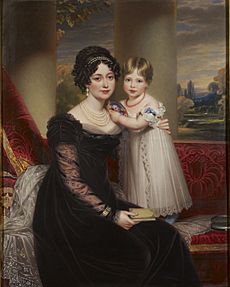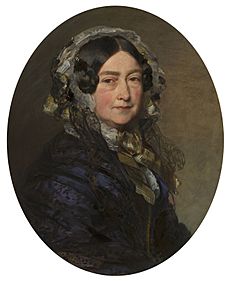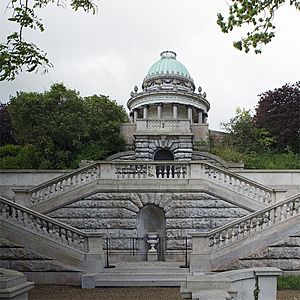Princess Victoria of Saxe-Coburg-Saalfeld facts for kids
Quick facts for kids Victoria of Saxe-Coburg-Saalfeld |
|||||
|---|---|---|---|---|---|
| Princess of Leiningen Duchess of Kent and Strathearn |
|||||
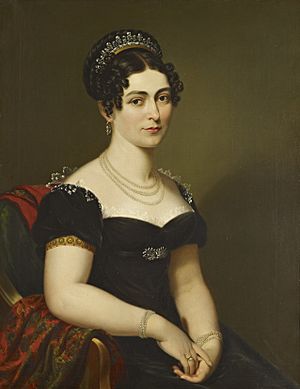
Portrait by George Dawe, 1818
|
|||||
| Born | 17 August 1786 Coburg, Saxe-Coburg-Saalfeld, Holy Roman Empire |
||||
| Died | 16 March 1861 (aged 74) Frogmore House, Windsor, Berkshire, England |
||||
| Burial | 25 March 1861
|
||||
| Spouse |
Emich Karl, Prince of Leiningen
(m. 1803; died 1814) |
||||
| Issue |
|
||||
|
|||||
| House |
|
||||
| Father | Francis, Duke of Saxe-Coburg-Saalfeld | ||||
| Mother | Augusta of Reuss-Ebersdorf | ||||
Princess Victoria of Saxe-Coburg-Saalfeld (born Marie Louise Victoire; 17 August 1786 – 16 March 1861) was a German princess. She became the mother of Queen Victoria of the United Kingdom.
Victoria was first married to Charles, Prince of Leiningen. After he died, she became a regent, ruling the Principality for her young son. Later, she married Prince Edward, Duke of Kent and Strathearn, who was the fourth son of King George III of Great Britain.
Contents
Early Life of Princess Victoria
Victoria was born in Coburg, a city in what was then the Holy Roman Empire of the German Nation. Her birthday was 17 August 1786. She was given the name Marie Louise Victoire.
She was the seventh child of Franz Frederick Anton, Duke of Saxe-Coburg-Saalfeld, and Countess Augusta of Reuss-Ebersdorf. One of her brothers was Ernest I. Another brother, Leopold, later became the first King of the Belgians. Leopold had married Princess Charlotte, who was expected to become the Queen of Britain.
Her Marriages
First Marriage and Children
On 21 December 1803, Victoria married Emich Karl, Prince of Leiningen in Coburg. He was much older than her. This was his second marriage.
Victoria and Charles had two children together. Their son, Prince Carl, was born in 1804. Their daughter, Princess Feodora of Leiningen, was born in 1807.
Through this marriage, Victoria is an ancestor to many royal families in Europe today. This includes Carl XVI Gustaf of Sweden and Felipe VI of Spain.
Becoming a Regent
After her first husband died in 1814, Victoria became the regent of the Principality of Leiningen. This meant she ruled the area because her son, Carl, was too young to do so himself.
Second Marriage and Queen Victoria's Birth
In 1817, a big event happened that changed the British royal family. Princess Charlotte, who was expected to be the next queen, died. This caused a "succession crisis" because there were no clear heirs to the throne.
To solve this, three of King George III's sons decided to marry. One of them was Prince Edward, Duke of Kent and Strathearn. He proposed to Victoria, and she accepted. They married on 29 May 1818 in Germany. They had another ceremony in England on 11 July 1818.
Soon after their wedding, the Kents moved to Germany. They wanted to save money because living there was cheaper. However, Victoria became pregnant. They decided their child must be born in England. They quickly traveled back and arrived in Dover in April 1819.
They moved into Kensington Palace in London. On 24 May 1819, Victoria gave birth to a daughter. This baby was named Princess Alexandrina Victoria of Kent. She would later become the famous Queen Victoria.
Life as a Widow
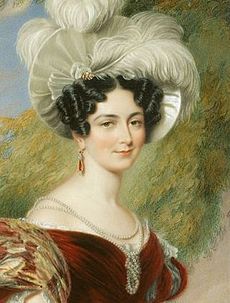
Prince Edward, Victoria's second husband, died suddenly in January 1820. He died just six days before his father, King George III.
Victoria, now a widow again, didn't speak English well. She also had a palace in her home country of Coburg where she could live cheaply. However, she decided to stay in the United Kingdom. She believed her daughter, young Princess Victoria, had a good chance of becoming queen.
At first, the British Parliament did not give her much money. She lived in a part of Kensington Palace that was not in good condition. Her brother, Leopold, helped her financially. He had a large income from the British Parliament.
By 1831, the situation changed. King George IV had died, and the new king, William IV, was over 60. He had no children who could inherit the throne. This meant young Princess Victoria was now very likely to become queen. As a result, Parliament increased the money given to the Duchess of Kent and her daughter.
Raising a Future Queen
Victoria raised her daughter, Princess Victoria, under a very strict set of rules called the "Kensington System." This system was designed to keep the princess very protected and dependent on her mother and her mother's helper, Sir John Conroy.
The system kept Princess Victoria isolated from most other children. It also limited her contact with many members of her father's family. The Duchess and Conroy wanted to make sure they would have a lot of power if Victoria became queen while still young.
Princess Victoria shared a bedroom with her mother every night. She had private teachers and spent her free time with her dolls and her dog, Dash.
The Duchess of Kent and Sir John Conroy were not popular with the rest of the royal family. King William IV, Victoria's uncle, was especially unhappy. The Duchess often prevented the King from seeing his niece. She even refused to let her daughter attend William's coronation.
In 1831, the Duchess and Conroy took Princess Victoria on several trips around the country. This was to show her to the public and strengthen their position as potential regents. Their plan worked, and it was announced that the Duchess would be the sole regent if Victoria became queen while still young.
The King and Queen Adelaide were fond of Princess Victoria. But the conflict with the Duchess of Kent made it hard for them to have a close relationship. At a birthday dinner in 1836, King William IV publicly said he hoped to live long enough for Princess Victoria to turn 18. This way, the Duchess of Kent would never become regent.
When Victoria became queen in 1837, she was 18 years old. This meant she did not need a regent. She was upset about how her mother and Conroy had tried to control her. As a result, she gave her mother separate living areas, away from her own.
Reconciliation
When Queen Victoria had her first child, the Princess Royal, things changed. The Duchess of Kent was welcomed back into Queen Victoria's close family.
This happened partly because Queen Victoria's husband, Prince Albert, helped. He encouraged Victoria to make up with her mother. Also, Sir John Conroy was no longer around, which removed a source of conflict.
The Duchess's money problems, which Conroy had made worse, were fixed by Queen Victoria. The Duchess became a loving grandmother. She grew much closer to her daughter than she had ever been before.
Death
The Duchess of Kent died on 16 March 1861, at 74 years old. Her daughter, Queen Victoria, was with her.
Queen Victoria was very sad about her mother's death. She read her mother's old papers and realized her mother had loved her deeply. This made her heartbroken. She felt that Conroy and others had wrongly kept her and her mother apart.
The Duchess is buried in the Duchess of Kent's Mausoleum at Frogmore, near Windsor Castle. Queen Victoria and Prince Albert dedicated a window in the Royal Chapel of All Saints to her memory.
Portrayal in Media
Princess Victoria of Saxe-Coburg-Saalfeld has been shown in many films and TV shows.
- Alison Leggatt played her in the 1975 TV drama Edward the Seventh.
- Penelope Wilton played her in the 2001 TV series Victoria and Albert.
- Miranda Richardson played her in the 2009 film The Young Victoria.
- Catherine Flemming played her in the 2016 ITV series Victoria.
See also
 In Spanish: Victoria de Sajonia-Coburgo-Saalfeld para niños
In Spanish: Victoria de Sajonia-Coburgo-Saalfeld para niños


